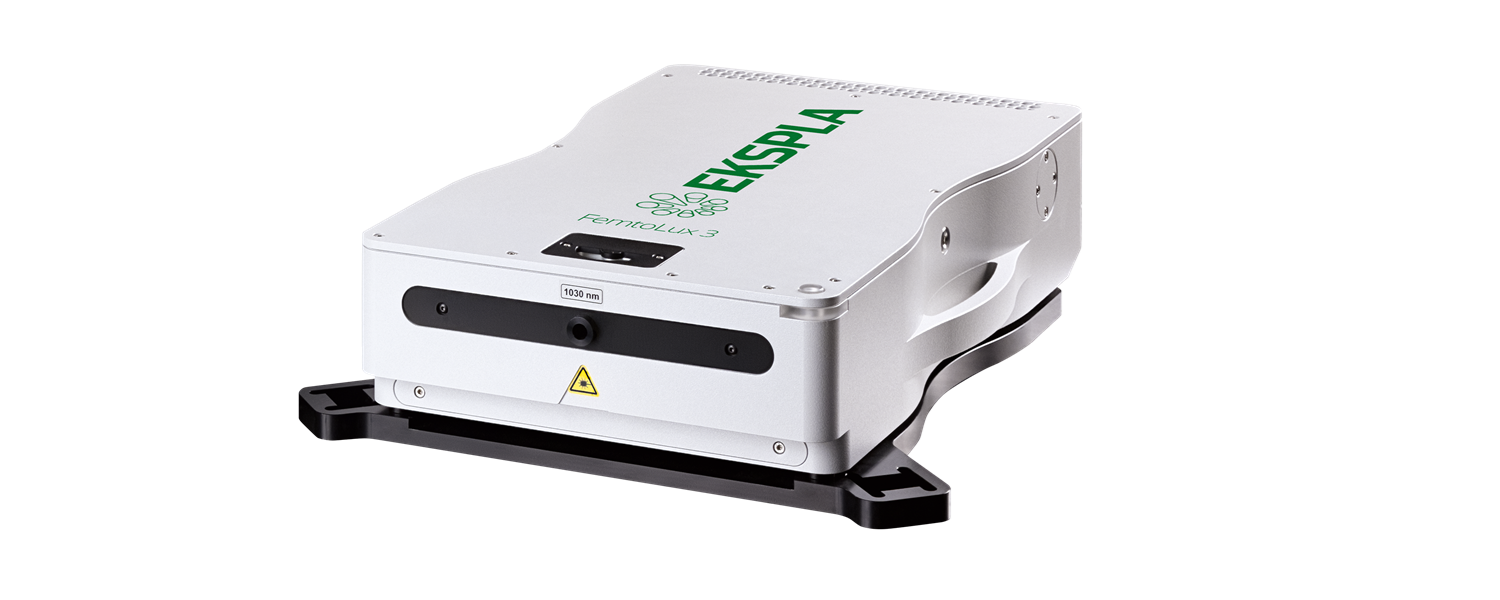FemtoLux3
3Watt - Femtosekundenlaser für Wissenschaft und Industrie
Der FemtoLux3 ist ein moderner Femtosekunden Faser-Laser für Wissenschaft und Industrie. Er liefert 3W Ausgangsleistung und ist für eine Vielzahl verschiedener Anwendungen geeignet,
wie z. B. Markieren, Ophthalmologie, Polymer-Bearbeitung, Biologische Bildgebung, Nichtlineare Mikroskopie und viele andere.

Features
- Bei 1030nm
3W typische mittl. Leistung und > 3 µJ maximale Pulsenergie - Burst Mode: > 10 µJ Gesamtenergie in Pulszug
- Optionale zweite Harmonische mit
515nm: 1,2 W mittlere Leistung und > 1,2 µJ maximale Pulsenergie - < 300 fs – 5 ps einstellbare Pulsdauer
- Bis 10 MHz einstellbare Repetitionsrate
- Externe Synchronisation für Scanner und PSO
- Anschluss für externe schnelle Leistungsmodulation
- Passiv, rein luftgekühlt
- M² < 1.2
- Strahl Zirkularität > 0.85
- Wartungsfrei
- „Dry cooling“ (kein Wasserkreislauf)
- Turn-Key System
- für 24/7 Betrieb
Anwendungen
- Intra-Volumen-Markieren von transparenten Materialien
- Markieren und Oberflächenstrukturierung
- Mikrobearbeitung von spröden Materialien
- Photo-Polymerisation
- Ophthalmologie
- Biologische Bildgebung
- Mikroskopie
Wissenschafliche Veröffentlichungen
Acoustic resonance effects and cavitation in SAW aerosol generation
M. Roudini, J. Manuel Rosselló, O. Manor, C. Ohl, and A. Winkler, Ultrasonics Sonochemistry 98, 106530 (2023). DOI: 10.1016/j.ultsonch.2023.106530.
The interaction of surface acoustic waves (SAWs) with liquids enables the production of aerosols with adjustable droplet sizes in the micrometer range expelled from a very compact source. Understanding the nonlinear acousto-hydrodynamics of SAWs with a regulated micro-scale liquid film is essential for acousto-microfluidics platforms, particularly aerosol generators. In this study, we demonstrate the presence of micro-cavitation in an MHz-frequency SAW aerosol generation platform, which is touted as a leap in aerosol technology with versatile application fields including biomolecule inhalation therapy, micro-chromatography and spectroscopy, olfactory displays, and material deposition. Using analysis methods with high temporal and spatial resolution, we demonstrate that SAWs stabilize spatially arranged liquid micro-domes atop the generator’s surface. Our experiments show that these liquid domes become acoustic resonators with highly fluctuating pressure amplitudes that can even nucleate cavitation bubbles, as supported by analytical modeling. The observed fragmentation of liquid domes indicates the participation of three droplet generation mechanisms, including cavitation and capillary-wave instabilities. During aerosol generation, the cavitation bubbles contribute to the ejection of droplets from the liquid domes and also explain observed microstructural damage patterns on the chip surface eventually caused by cavitation-based erosion.
Characterization of pathological stomach tissue using polarization-sensitive second harmonic generation microscopy
H. Jeon, M. Harvey, R. Cisek, E. Bennett, and D. Tokarz, Biomed. Opt. Express 14 (10), 5376-5391 (2023). DOI: 10.1364/BOE.500335.
Alterations in collagen ultrastructure between human gastric adenocarcinoma and normal gastric tissue were investigated using polarization-resolved second harmonic generation (PSHG) microscopy. Cylindrical and trigonal symmetries were assumed to extract quantitative PSHG parameters, ρ, κ and S, from each image pixel. Statistically significant variations in these values were observed for gastric adenocarcinoma, indicating a higher disorder of collagen. Numerical focal volume simulations of crossing fibrils indicate increased S parameter is due to more intersecting collagen fibrils of varying diameters. These parameters were also able to distinguish between different grades of gastric adenocarcinoma indicating that PSHG may be useful for automated cancer diagnosis.
Clean production and characterization of nanobubbles using laser energy deposition
J. M. Rosselló, and C. Ohl, Ultrasonics Sonochemistry 94, 106321 (2023). DOI: 10.1016/j.ultsonch.2023.106321.
We have demonstrated the production of laser bulk nanobubbles (BNB) with ambient radii typically below 500 nm. The gaseous nature of the nanometric objects was confirmed by a focused acoustic pulse that expands the gas cavities to a size that can be visualized with optical microscopy. The BNBs were produced on demand by a collimated high-energy laser pulse in a “clean” way, meaning that no solid particles or drops were introduced in the sample by the generation method. This is a clear advantage relative to the other standard BNB production techniques. Accordingly, the role of nanometric particles in laser bubble production is discussed. The characteristics of the nanobubbles were evaluated with two alternative methods. The first one measures the response of the BNBs to acoustic pulses of increasing amplitude to estimate their rest radius through the calculation of the dynamics Blake threshold. The second one is based on the bubble dissolution dynamics and the correlation of the bubble’s lifetime with its initial size. The high reproducibility of the present system in combination with automated data acquisition and analysis constitutes a sound tool for studying the effects of the liquid and gas properties on the stability of the BNBs solution.
